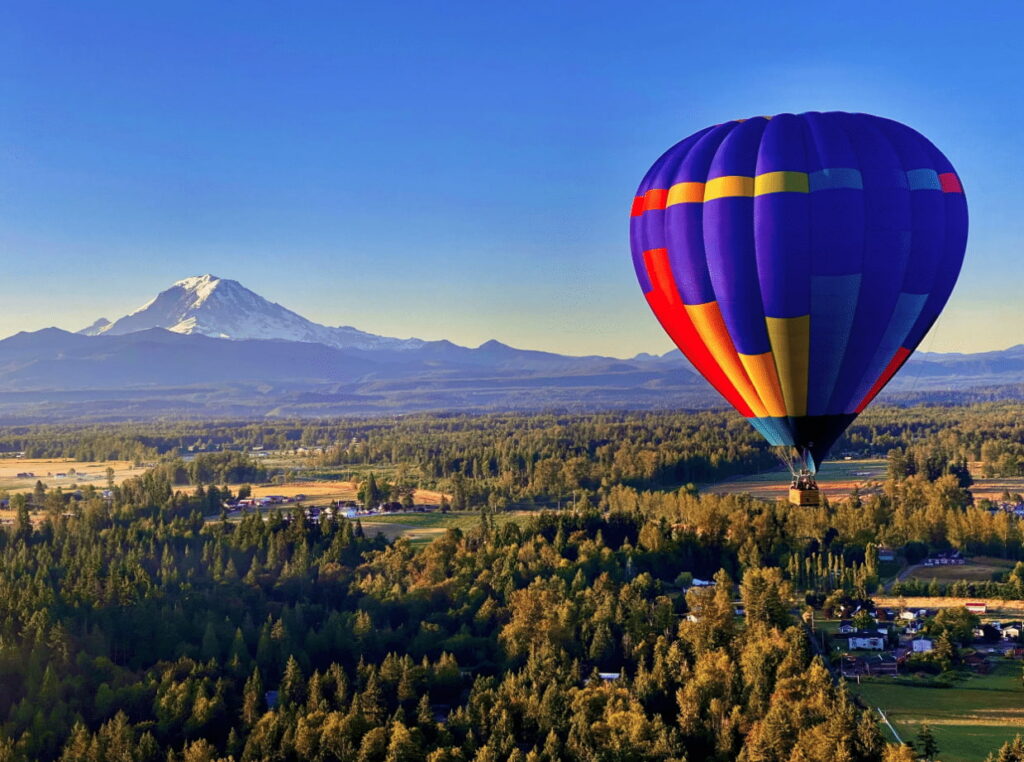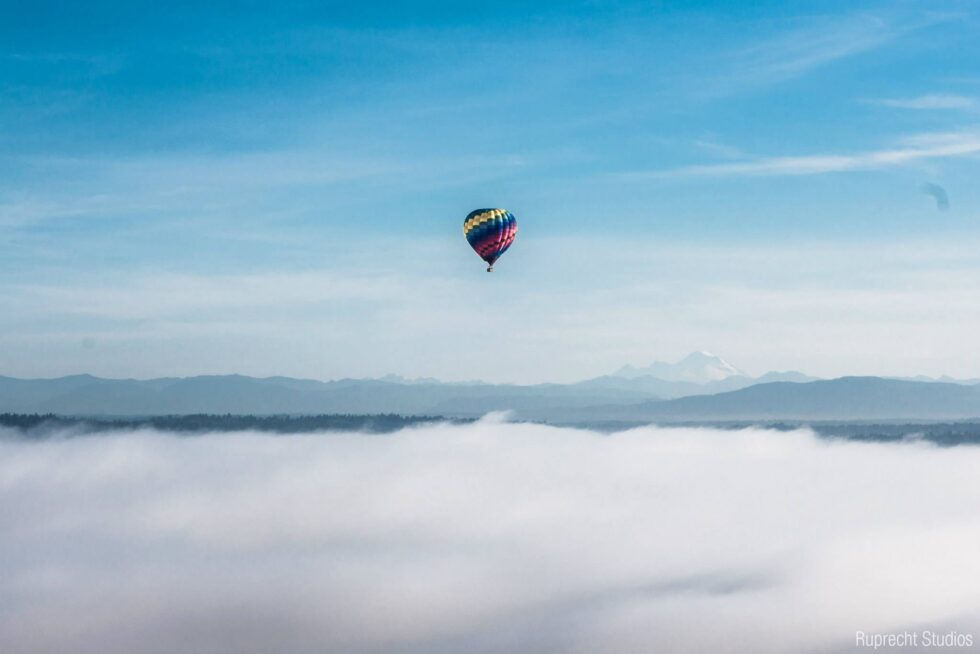Can You Steer A Hot Air Balloon?
Yes, you can steer a hot air balloon! Hot air balloons don’t have steering wheels, but hot air balloon pilots use the wind direction and speed at different heights in order to control the direction and steer the balloon. Hot air balloon pilots control their ascent and descent but can’t steer the balloon horizontally without changing altitude.
How Do Hot Air Balloons Control Their Altitude?
It’s pretty simple: Hot air balloon pilots use the burner to add heat to the balloon to ascend and can use a vent at the top of the balloon to release hot air and cool the balloon to descend.
Heating The Air Inside The Balloon
To gain altitude or rise, balloon pilots introduce heat into the balloon’s envelope by firing up the burner. The burner combusts propane on the pilot lights, producing a flame that directly heats the air inside the envelope. As the air inside warms, it expands and becomes less dense than the cooler air outside. This causes the balloon to rise.
Cooling The Air
To lose altitude or descend, hot air balloon pilots reduce the burner’s flame or turn it off to allow the air inside the balloon to cool. As the air cools, it contracts and becomes denser, causing the balloon to descend. Additionally, many hot air balloons have a vent at the top, known as a “parachute valve” or “deflation port,” which the pilot can open to release hot air quickly, making the balloon descend faster if needed. Vents are primarily used during landing to help balloon pilots land their balloons in an appropriate and safe area.
Steering A Hot Air Balloon Is Both Art And Science
Steering hot air balloons to specific landing sites is an art and science. Surprisingly at Seattle Ballooning, we steer our balloons to the same 6 landing sites 74% of the time. It doesn’t matter if it’s a sunrise or sunset hot air balloon ride, our experienced balloon pilots are able to control the balloon and navigate to specific locations. The weather and wind is different on every flight, but by understanding the winds aloft can really help a balloon pilot get to the location they want. By the end of this article, you’ll have a deep understanding of how hot air balloon pilots flight plan and steer balloons. Balloon navigation and flight planning can be broken down into a few areas. Pre-flight wind direction and weather conditions, on-field observed wind direction, in fight surface wind direction, and winds at altitude.

Pre-Flight Weather And General Direction Of Flight
So where does the weather education process start before your balloon ride? Our process at Seattle Ballooning starts 72 hours out. A final decision is made a few hours before the planned hot air balloon ride. Balloon pilots get weather and wind information from a variety of sources. Our pilots at Seattle Ballooning have a few favorites:
Weather Resources
● Usairnet.com – Usairnet gives a good general idea of the ground wind direction and whether there will be strong winds or slow winds on the surface. It also shows the temperature, air pressure, humidity, and dew point spread (basically it tells you if it will be a good day to fly and what altitude the clouds will be at).
● RUC Sounding display – This is an amazing weather resource for balloon pilots as it gives specific atmospheric conditions. It’s a little more technical, but it shows you how the wind direction and speed will change during the balloon flight time. It also can show you if fog or onshore flow is forecasted for a specific time. Often it can look beautiful out with slow surface winds. What you learn from resources like this is, that the wind at 200 feet off the ground may be doing 20 Mph halfway through your flight.
● Washington Weather Discussion – In the state of Washington, we are very lucky to have the University of Washington. They provide detailed, updated weather discussions every 6 hours.
● Our pilots have access to real-time radar using Foreflight and other weather-related applications directly on their mobile devices.
Prior to the flight, all our pilots use 1-800-WX-BRIEF and speak to a flight briefer. These flight briefers have an arsenal of tools and can be very helpful in confirming information about thunderstorms and unexpected weather phenomena.
If the weather conditions look promising, the hot air balloon pilot, passengers, and ground crew will head out to a launch location. Most hot air balloon pilots have 5 -10 launch locations in all directions over a 10-mile radius. That way no matter the direction of the wind, they are able to fly and steer their balloon to a good landing site. That makes sense, right? During the drive to the launch locations, pilots gather key data by keeping their eyes out for signs of what the wind is doing on the surface. Flags, smoke, and how much the tree branches are moving can give valuable information. For safe operation, balloon pilots do not typically launch balloons in more than 12 Kts of wind.

At The Balloon Launch Location: On-Field Observed Wind Direction
At Seattle Ballooning, we use 17″ balloons, otherwise known as Pibals. We fill our pibals with helium or hydrogen, release it in the air, and try to watch it for as long as possible (sometimes up to 8 minutes). Helium pibals rise at approximately 400 feet per minute, allowing balloon pilots to determine the direction and speed of the winds aloft. From an outsider’s view, it is very confusing to see 10 random people looking up into the sky for 6-8 minutes. If the direction and speed are consistent with the forecasted winds, the balloon pilot and crew will start the inflation process.
In-Flight Surface Wind
Ok! The nylon fabric balloon is inflated, the propane burner is on, the passengers are loaded, and the hot air balloon launches into the air. After initially ascending to 1000 feet, it’s important to see what kind of steerage there is below. The wind direction changes for a variety of reasons. Almost all wind is created by differences in pressure and changes in temperature. If the sun is out and warming up the surface of the earth (convection heating), the wind will be constantly changing. So do balloon pilots have X-ray vision that allows them to see the wind? I wish. Instead balloon pilots drop items out of the balloon basket. The FAA’s rule is you can actually drop anything out of an aircraft as long as it does not damage any person or property.
X-Ray Vision: Seeing Winds Beneath You
Balloon pilots drop objects that are light and can easily be carried by the wind. Many pilots use the age-old technique of spitting over the side of the balloon basket and watching intently as the wind shifts it from side to side. This works great, except sometimes becomes difficult as you run out of saliva about halfway through the flight. The classier way is to use shaving cream or popcorn! Shaving cream is light in weight and when sprayed over the side of the basket can be easily seen for a few thousand feet. Every hot air balloon pilot has their favorite wind discovery device. I’ve seen hot air balloon pilots use shaving cream, popcorn, rose petals, wood shavings, and even cheezy poofs! If one morning, you’re on your porch drinking a warm cup of coffee, and a cheesy poof lands in your cup, you’ll know it’s just a hot air balloon pilot trying to see what the winds are doing.
When a balloon pilot knows what the winds are doing on the surface, and aloft, it’s possible to steer the balloon to a specific area. The balloon pilot tacks by going up and down in altitude. Sometimes, that change in direction requires the balloon to ascend 5000 ft – 8000 ft. One of the challenges of piloting a hot air balloon is that we are limited by airspace. Hot air balloons rarely use Class B airspace as it requires a transponder and talking to a major airport’s tower. This means there may be wind going in a different direction you want at altitude, but you don’t have permission to use it.
How Do Hot Air Balloons Land?
Hot air ballooning is an incredible sport. However, landing can be challenging depending on the wind conditions. Hot air balloon landings are very different from traditional aircraft that have wheels. As the balloon approaches a landing location, the pilot will descend the balloon under 500 feet. Next time you see a balloon right at tree top, or flying low over houses, you’ll know it’s just a balloon about to land. When an appropriate location is selected, the pilot will bring the balloon down to a few feet above the surface and pull the deflation valve line. This valve lets hot air out the top of the balloon and allows the balloon basket to land softly on the ground. Our commercial hot air balloons at Seattle Ballooning use state-of-the-art parachute valves, giving our pilots better control on final landing approaches.
How Specific Can You Steer A Hot Air Balloon (That’s What Hot Air Balloon Competition Is All About)
Our team of pilots at Seattle Ballooning loves to compete on the national and world levels. Competitive ballooning combines the precision of Golf, the directional use of wind for sailing, and Nascar, as up to 115 competitors fly at a time. Amanda, one of our pilots, is the current US Female Champion. Pilot Cameron participated in JR Worlds last year, and Pilot Eliav is competing at the World Balloon Competition in Hungary this September!
Now that you know how pilots steer hot air balloons, you’re either ready to start your training or probably ready to book your hot air balloon flight. Check out the History of Ballooning and When the Hot Air Balloon was Invented! The best way to book your flight is at http://www.seattleballooning.com

Want To Learn More About How Hot Air Balloons Work?
We wrote a great article that goes into depth about how hot air balloons work. Hope you enjoy it!
Interested in buying a hot air balloon? Check out our Guide To Buying A Used Or New Hot Air Balloon
